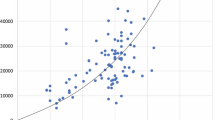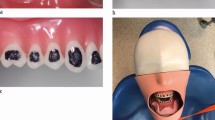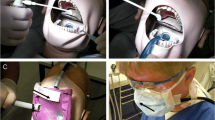Abstract
Particles in a dental office can be generated by a number of instruments, such as air-turbine handpieces, low-speed handpieces, ultrasonic scalers, bicarbonate polishers, polishing cups, as well as drilling and air sprays inside the oral cavity. This study examined the generation of particles during dental drilling and measured particle size, mass, and trace elements. The air sampling techniques included both continuous and integrated methods. The following particle continuous measurements were taken every minute: (1) size-selective particle number concentration (Climet); (2) total particle number concentration (PTRAK), and; (3) particle mass concentration (DustTrak). Integrated particle samples were collected for about 5 h on each of five sampling days, using a PM2.5 sampler (ChemComb) for elemental/organic carbon analysis, and a PM10 sampler (Harvard Impactor) for mass and elemental analyses. There was strong evidence that these procedures result in particle concentrations above background. The dental procedures produced number concentrations of relatively small particles (<0.5 μm) that were much higher than concentrations produced for the relatively larger particles (>0.5 μm). Also, these dental procedures caused significant elevation above background of certain trace elements (measured by X-ray fluorescence) but did not cause any elevation of elemental carbon (measured by thermal optical reflectance). Dental drilling procedures aerosolize saliva and products of drilling, producing particles small enough to penetrate deep into the lungs. The potential health impacts of the exposure of dental personnel to such particles need to be evaluated. Increased ventilation and personal breathing protection could be used to minimize harmful effects.
Similar content being viewed by others
References
Anders, J. T. (1957) The chloride level of saliva. II. Journal of Dental Research, 36, 230–232.
Babich, P., Davey, M., Allen, G., & Koutrakis, P. (2000). Method comparisons for particulate nitrate, elemental carbon, and PM2.5 mass in seven U.S. cities. Journal of the Air & Waste Management Association, 50, 1095–1105.
Bennett, A. M., Fulford, M. R., Walker, J. T., Bradshaw, D. J., Martin, M. V., & Marsh, P. D (2000). Microbial aerosols in general dental practice. British Dental Journal, 189, 664–667.
Bentley C. D., Burkhart, N. W., & Crawford, J. J. (1994) Evaluating spatter and aerosol contamination during dental procedures. Journal of the American Dental Association, 125, 579–584.
Faecher, R. S., Thomas, J. E., & Bender, B. S (1993) Tuberculosis: A growing concern for dentistry. Journal of the American Dental Association, 124, 94–104.
Harrel, S. K., Barnes, J. B., & Rivera-Hidalgo, F. (1996). Reduction of aerosols produced by ultrasonic scalers. Journal of Periodontology, 67, 28–32.
Harrel, S. K., Barnes, J. B., & Rivera-Hidalgo, F. (1998). Aerosol and splatter contamination from the operative site during ultrasonic scaling. Journal of the American Dental Association, 129, 1241–1249.
Harrel, S. K., & Molinari, J (2004). Aerosols and splatter in dentistry: A brief review of the literature and infection control implications. Journal of the American Dental Association, 135, 429–437.
Hatami, P., Peyrovan, H., Afarideh, H., & Shojaei, S. (1997). Determination of trace elements in human saliva by PIXE technique. International Journal of PIXE, 6, 273–276.
Janssen, N. A. H., vanVliet, P. H. N., Aarts, F., Harssema, H., & Brunkreef, B. (2001). Assessment of exposure to traffic related pollution of children attending schools near motorways. Atmospheric Environment, 35, 3875–3884.
Kim, J. Y., Magari, S. R., Herrick, R. F., Smith, T. J., & Christiani, D. C. (2004). Comparison of fine particle measurements from a direct-reading instrument and a gravimetric sampling method. Journal of Occupational and Environmental Hygiene, 1, 707–715.
Kingham, S., Durand, M., Aberkane, T., Harrison, J., Wilson, J. G., Epton, M. (2006). Winter comparison of TEOM, MiniVol, and DustTrak PM10 monitors in a woodsmoke environment. Atmospheric Environment, 40, 338–347.
Kugel, G., Garcia-Godoy, F. (2001). Direct and indirect esthetic adhesive restorative materials: A review. Your Practice Builder, Oct 2001. (http://healthmantra.com/ypb/oct%2001/new%20composite%20class%20materials.htm).
Lagerlof, F., & Matsuo, S. (1991). Ion-selective minielectrode determination of ionic and total calcium concentrations in mixed saliva. Clinica Chimica Acta, 198, 175–181.
Lear, R. D., & Groen, P. (1968). Magnesium in human saliva. Archives of Oral Biology, 13, 1311–1319.
Legnani, P., Checchi, L, Pelliccioni, G. A., & D’Achille, C. (1994). Atmospheric contamination during dental procedures. Quintessence International, 25, 435–439.
Logothetis, D. D., & Martinez-Welles, J. M. (1995). Reducing bacteria aerosol contamination with a chlorhexidine gluconate pre-rinse. Journal of the American Dental Association, 126, 1634–1639.
Long, C. M., Suh, H. H., Kobzik, L., Catalano, P. J., Ning, Y. Y., & Koutrakis, P. (2001). A pilot investigation of the relative toxicity of indoor and outdoor fine particles: In vitro effects of endotoxin and other particulate properties. Environmental Health Perspectives, 109, 1019–1026.
Losee, F. L., Curzon, M. E., & Little, M. F. (1974). Trace element concentrations in human enamel. Archives of Oral Biology, 19, 467–470.
Nimmo, A., Werley, M. S., Martin, J. S., & Tansy, M. F. (1990) Particulate inhalation during the removal of amalgam restorations. Journal of Prosthetic Dentistry, 63, 228–233.
Sen, D., Goller, G., & Issever, H. (2002). The effect of two polishing pastes on the surface roughness of bis-acryl composite and methacrylate-based resins. Journal of Prosthetic Dentistry, 88, 527–532.
Shannon, I. L. (1970). Pumice-zirconium silicate prophylaxis paste containing 2% stannous fluoride in water-free solution. Pharmacology and Therapeutics in Dentistry, 1, 24–30.
Shannon, I. L., & Prigmore, J. R. (1962). Human whole stimulated saliva sodium and potassium concentrations during 16 hours of the day. Journal of Dental Research, 41, 23–28.
Skrtic, D., Antonucci, J. M., Eanes, E. D., & Eidelman, N. (2003). Dental composites based on hybrid and surface-modified amorphous calcium phosphates. Biomaterials, 25, 1141–1150.
Turpin, B. J., & Lim, H. J. (2001). Species contributions to PM2.5 mass concentrations: Revisiting common assumptions for estimating organic mass. Aerosol Science and Technology, 35, 602–610.
US Environmental Protection Agency (USEPA) (1990) National Ambient Air Quality Standards (NAAQS), (http://www.epa.gov/air/criteria.html).
Wallace, L., & Howard-Reed, C. (2002). Continuous monitoring of ultrafine, fine, and coarse particles in a residence for 18 months in 1999–2000. Journal of Air & Waste Management Association, 52, 828–844.
Wu, C. F., Delfino, R. J., Floro, J. N., Samimi, B. S., Quintana, P. J. E., Kleinman, M. T. (2005). Evaluation and quality control of personal nephelometers in indoor, outdoor and personal environments. Journal of Exposure Analysis and Environmental Epidemiology, 15, 99–110.
Yanosky, J. D., Williams, P. L., & MacIntosh, D. L. (2002). A comparison of two direct-reading aerosol monitors with the federal reference method for PM2.5 in indoor air. Atmospheric Environment, 36, 107–113.
Zhou, M. S., Drummond, J. L., & Hanley, L. (2005). Barium and strontium leaching from aged glass particle/resin matrix dental composites. Dental Materials, 21, 145–155.
Author information
Authors and Affiliations
Corresponding author
Rights and permissions
About this article
Cite this article
Sotiriou, M., Ferguson, S.F., Davey, M. et al. Measurement of particle concentrations in a dental office. Environ Monit Assess 137, 351–361 (2008). https://doi.org/10.1007/s10661-007-9770-7
Received:
Accepted:
Published:
Issue Date:
DOI: https://doi.org/10.1007/s10661-007-9770-7




